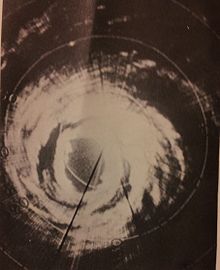Hurricane Debbie (1969)
The hurricane bypassed the island of Bermuda to the southeast on August 22, before ultimately brushing southeastern Newfoundland with strong winds.
Although Debbie had little effect on land, it was extensively researched and was subject to a weather modification experiment by Project Stormfury, in which it was seeded with silver iodide.
After attaining an initial peak of 105 mph (165 km/h) six hours later, Debbie oscillated in strength over the succeeding two days, weakening back to Category 1 status early on August 19.
[1][5] Debbie's abrupt fluctuation in intensity may have been the result of a seeding experiment carried out on the storm in an attempt to weaken it, though posthumous assessment by the Atlantic hurricane reanalysis project determined that an eyewall replacement cycle was more likely responsible.
[1] By 12:00 UTC on August 23, Debbie weakened to below Category 2 status and turned northward, becoming extratropical six hours later, while still retaining winds of hurricane force.
[9] Debbie was subject to an experiment called Project Stormfury, which attempted to weaken tropical cyclones by seeding them with silver iodide.
[10] However, later studies determined that Project Stormfury likely had little or no impact on the evolution of Debbie and other storms, positing instead that natural fluctuations induced by eyewall replacement cycles were more likely to blame.

Tropical storm (39–73 mph, 63–118 km/h)
Category 1 (74–95 mph, 119–153 km/h)
Category 2 (96–110 mph, 154–177 km/h)
Category 3 (111–129 mph, 178–208 km/h)
Category 4 (130–156 mph, 209–251 km/h)
Category 5 (≥157 mph, ≥252 km/h)
Unknown

